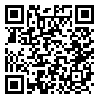Volume 18, Issue 44 (No.3&4-مقالات ریاضی از صفحه 213 تا 240 و یک مقاله زمین از صفحه 241 تا 248 و چکیده از 249 تا 255 2009)
2009, 18(44): 941-946 |
Back to browse issues page
Download citation:
BibTeX | RIS | EndNote | Medlars | ProCite | Reference Manager | RefWorks
Send citation to:



BibTeX | RIS | EndNote | Medlars | ProCite | Reference Manager | RefWorks
Send citation to:
Study on Probiotic Properties of Lactobacillus Isolated from Traditional dairy Products of Lighvan. Journal title 2009; 18 (44) :941-946
URL: http://jsci.khu.ac.ir/article-1-1212-en.html
URL: http://jsci.khu.ac.ir/article-1-1212-en.html
Abstract: (7492 Views)
In order to increase public health many study have been performed with adding probiotic bacteria in dairy products. In this filed on of the most critical problem is unfavorable taste and aroma produced by probiotic bacteria. So isolation probiotic bacteria from traditional dairy product could solve this problem. A rapid screening method is used to isolate acid tolerant bacteria from 30 different fermented dairy products After enrichment samples in MRS broth followed acid stressing (pH=2.5) different colony were selected on MRS agar, avoiding preliminary time consuming isolation steps. All the isolates were examined by microscopy, gram staining and catalase reaction. Fifty-eight isolates were selected and defined as lactobacillus SPP. The screening at low pH bile salt led to the selection of 19 resistant isolates. Cholesterol assimilation determined by difference in cholesterol content in the medium before and after the incubation period, showed that all lactobacilli strains were able to assimilate cholesterol at varying levels ranging from 54 to 266 μg/ml .Most cholesterol assimilation were seen in L.farieminis ,L. planetarium ,L.alimentarium ,L.casei, L. acidophilus isolated from yogurt and cheese of lighvan region. These data showed yogurt and cheese of lighvan region have probiotic potential.
Published: 2009/10/15
| Rights and permissions | |
 | This work is licensed under a Creative Commons Attribution-NonCommercial 4.0 International License. |



